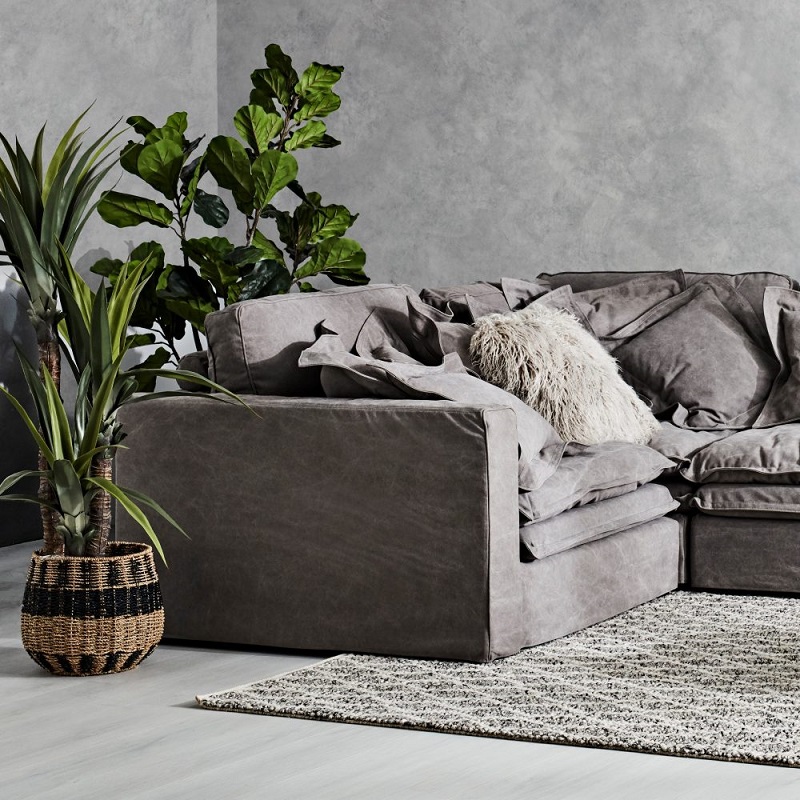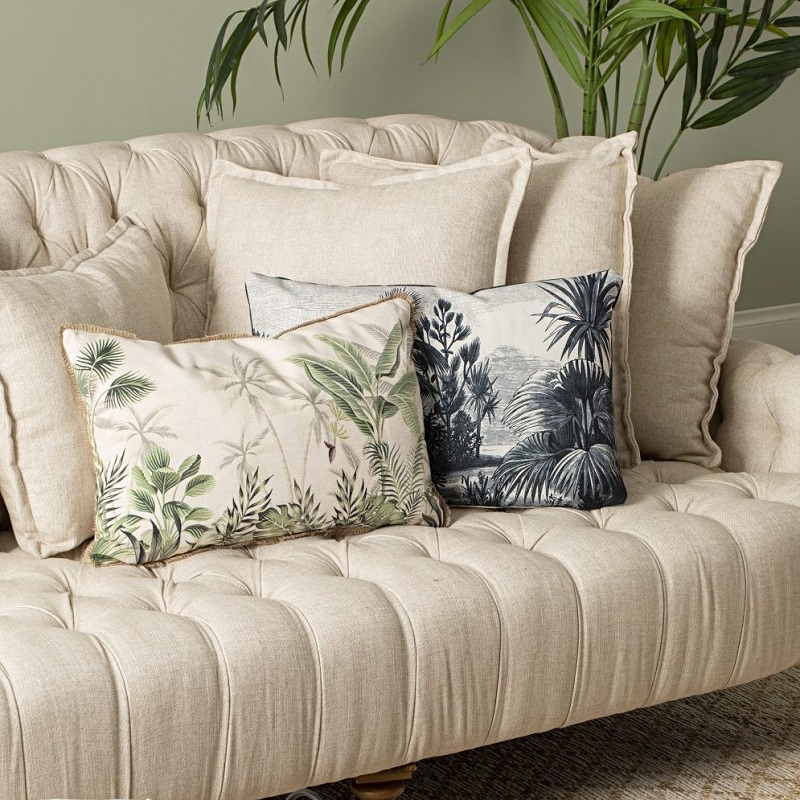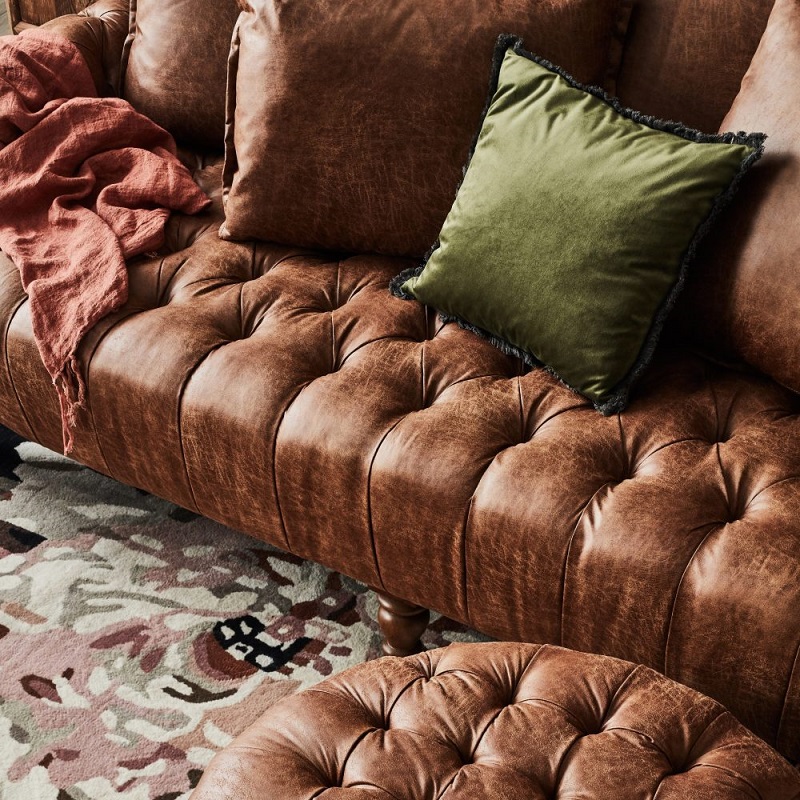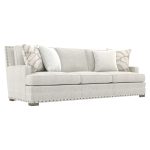Introduction to Sofa Materials
Selecting the right sofa material is essential for comfort, durability, and style. It can significantly impact your home’s aesthetic and your sofa’s longevity. With a variety of materials available, it’s important to understand the differences between them, how they perform, and what suits your living situation best. This guide will help you comprehend the pros and cons of both natural and synthetic fibers, as well as how different climates can affect your material choice.
Natural vs Synthetic Fibers
When it comes to sofa fabrics, you have two main categories: natural fibers and synthetic fibers. Natural fibers, such as cotton, linen, leather, silk, and wool, are derived from plants and animals. They are known for their comfort and environmental friendliness but might require more care. Synthetic fibers, on the other hand, include polyester, microfiber, acrylic, faux leather, and velvet. These are man-made and boast greater stain resistance and durability at often lower costs.
The Impact of Climate on Material Choice
Your local climate should influence your sofa material choice. In hot and humid conditions, breathable fabrics like linen and cotton are ideal as they allow air flow and moisture absorption. Conversely, cooler climates may benefit from the warmth and coziness provided by wool or leather. For regions with varied weather, synthetic fibers that can handle a range of temperatures while maintaining their appearance might be the best option.

Natural Fabric Options
When furnishing your home with a new sofa, natural fabrics often come to mind. They offer various benefits, such as breathability, elegance, and comfort. Let’s explore some popular natural sofa materials.
Linen: Breathability and Elegance
Linen is known for its incredible breathability, making it ideal for warm climates. Its elegance lends a touch of sophistication to any space. Its ability to handle moisture also makes it a solid choice for humid environments.
Cotton: Comfort and Versatility
Cotton is prized for its softness and versatility, fitting into most decors with ease. It is comfortable to the touch and friendly on the skin, making it a household favorite for families.
Leather: Durability and Timeless Appeal
Leather is a champion of durability and has a timeless appeal that never goes out of style. It ages gracefully, developing a rich patina over time, and is a top material for longevity.
Silk: Luxurious and Delicate
Silk oozes luxury with its smooth texture and sheen. It’s delicate, however, and best suited for low-traffic areas where its beauty won’t be compromised by the bustle of daily life.
Wool: Warmth and Durability
Wool is not only warm but also incredibly durable. It’s well-suited for cooler climates and homes seeking a cozy, inviting feel with a material that can stand the test of time.
In choosing between these natural fabrics, consider factors like your climate, usage, and the aesthetic you wish to achieve in your living space. Natural sofa materials can elevate your home’s comfort and style, promising an inviting atmosphere for all who enter.

Synthetic Fabric Alternatives
Moving on from natural fabrics, synthetic alternatives provide unique benefits worth considering for your sofa. They are often more resistant to wear and practical for busy households.
Polyester: Affordable and Durable
Polyester stands out as a cost-effective and resilient option. Its resistance to wrinkles, fading, and shrinking makes it a popular choice in modern homes.
Microfiber: Stain Resistance and Easy Cleaning
Microfiber is renowned for its ability to resist stains and its ease of cleaning. Ideal for homes with kids or pets, it promises stress-free maintenance.
Acrylic: Lightweight and Colorfast
Acrylic offers the look and feel of wool but without the weight. It holds color well, even with exposure to sunlight, making it a vibrant choice for lively interiors.
Faux Leather: Ethical and Economical
Faux leather provides the luxurious look of leather at a lower cost. It’s a compassionate choice for those seeking ethical alternatives to animal products.
Velvet: Plush Comfort and Rich Texture
Velvet delivers an opulent touch with its plush texture and deep color choices. It brings a sense of luxury and comfort to any room it graces.
Considerations for Material Selection
Choosing the best material for your sofa is important for both comfort and longevity. When selecting your sofa material, you need to consider several factors. These include how long the material lasts, how much care it needs, how it fits with your lifestyle, and how it aligns with any personal sensitivities.
Assessing Durability and Maintenance
In looking at durability, think about your daily life and what your sofa will go through. If you have children or pets, consider a material that is easier to clean and can handle more wear. Leather or microfiber could be great options. They are both durable and easier to maintain compared to delicate fabrics like silk.
Matching Materials with Lifestyle
Your sofa’s material should fit with how you live. For busy families, stain-resistant and tough fabrics are ideal. For those looking for luxury, leather or velvet may be the way to go, offering style and comfort.
Allergies and Sensitivity Concerns
Consider any allergies or sensitivities you or your family members might have. Natural fibers like cotton and linen are often better for sensitive skin. They don’t trap dust and allergens as much as some synthetic fabrics do.
Budgeting for Quality and Longevity
Consider how much you can spend on your sofa. Keep in mind, investing more upfront could save you money in the long run. Quality materials like top-grain leather may cost more but generally last longer. Meanwhile, there are budget-friendly options like polyester that also offer durability and style.

Specialty and Non-Fabric Materials
In addition to traditional fabrics, there are specialty and non-fabric materials that offer unique advantages for sofas. These include performance textiles and durable substances like wood, metal, and wicker. Let’s dive into some of these innovative options.
Performance Linen and Performance Leather
Performance linen combines the natural look of regular linen with enhanced durability. It resists stains and spills, making it ideal for busy households. Performance leather, on the other hand, receives special treatments for increased longevity. Both materials are designed to handle heavy use while maintaining their aesthetic appeal.
Performance linens resist wrinkles better than standard linen. They are easier to clean and often used in slipcovers. Performance leather is more resistant to fading and scratching. It requires less maintenance than traditional leather.
Both materials are excellent for those who want the luxury of linen or leather without the upkeep.
The Role of Wood, Metal, and Wicker
Wood, metal, and wicker are not just for framing sofas; they can be a part of the design too. Each brings a distinct style and feel to the furniture.
Wood offers a classic, warm touch. It is versatile, with different stains and treatments available to match any decor. Wood is durable and supports heavy weight.
Metal gives sofas a sleek, modern edge. It is sturdy and often used in contemporary design. However, metal can feel cold and might not be comfortable in cooler climates without proper cushions.
Wicker provides a rustic or tropical feel. It is lightweight and suitable for both indoor and outdoor sofas. Wicker is often made from rattan, which is strong but can be prone to damage from moisture and sunlight.
When considering these materials, think about your style needs, durability requirements, and maintenance preferences. Non-fabric materials can greatly enhance a sofa’s design and functionality.
Conclusion: Making an Informed Decision
Choosing the right sofa material requires a careful balance of aesthetics, functionality, and comfort. You should weigh the visual appeal against the practical needs of your household and the comfort level that each material provides. Considering these factors will help you make a well-informed decision that suits your home, lifestyle, and budget.
Balancing Aesthetics, Functionality, and Comfort
When selecting your sofa’s material, consider how it looks, functions, and feels. A stylish material may catch your eye, but it also needs to withstand daily use and fit into your life comfortably. Think about the overall design theme of your space. Whether it’s modern chic, classic elegance or cozy casual, your sofa should complement the interior while fulfilling its purpose as a comfortable and durable piece of furniture.
Taking Care of Your Sofa Material
Once you’ve picked out your sofa, taking proper care of it is key to ensuring its longevity. Read the cleaning instructions and follow them to keep the material in top shape. Natural materials like leather and linen may need specific products for cleaning and conditioning. Synthetic fibers are often easier to maintain, but they still require regular attention to keep them looking new. Make the effort to maintain your sofa, and it will be a valuable and lasting addition to your home.

